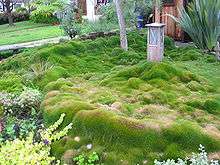Zoysia
| Zoysia | |
|---|---|
 | |
| cultivated Zoysia | |
| Scientific classification | |
| Kingdom: | Plantae |
| (unranked): | Angiosperms |
| (unranked): | Monocots |
| (unranked): | Commelinids |
| Order: | Poales |
| Family: | Poaceae |
| Subfamily: | Chloridoideae |
| Tribe: | Zoysieae |
| Genus: | Zoysia Willd.[1] |
| Synonyms[2] | |
| |
| Wikimedia Commons has media related to Zoysia. |
| Wikispecies has information related to: Zoysia |
Zoysia /ˈzɔɪziə/[3] is a genus of creeping grasses widespread across much of Asia as well as Australia and various islands in the Pacific. These species, commonly called zoysia or zoysiagrass, are found in coastal areas or grasslands.[4] The genus is named after the Slovenian botanist Karl von Zois (1756–1799).[5][6]
- Zoysia × forbesiana Traub - Japan - (Z. japonica × Z. matrella)
- Zoysia × hondana Ohwi - Japan - (Z. japonica × Z. macrostachya)
- Zoysia japonica Steud. - zenith zoysia - Japan (incl Bonin Is), Korea, China, Primorye; naturalized in India, North America, etc.
- Zoysia macrantha Desv. - Australia
- Zoysia macrostachya Franch. & Sav. - Japan, Korea, eastern China, Ryukyu Is
- Zoysia matrella (L.) Merr. - Southeast Asia, Japan, China, Indian Subcontinent, New Guinea, Queensland, Micronesia; naturalized in parts of Africa, North and South America, and assorted oceanic islands
- Zoysia minima (Colenso) Zotov - New Zealand
- Zoysia pauciflora Mez - North Island of New Zealand
- Zoysia seslerioides (Balansa) Clayton & F.R.Richardson - Vietnam
- Zoysia sinica Hance Japan, Korea, eastern China, Ryukyu Is
Cultivation and uses
Because they can tolerate wide variations in temperature, sunlight, and water, zoysia are widely used for lawns in temperate climates. They are used on golf courses to create fairways and teeing areas. Zoysia grasses stop erosion on slopes, and are excellent at repelling weeds throughout the year.[8] They resist disease and hold up well under traffic.[9]
The cultivar Zoysia 'Emerald' (Emerald Zoysia), a hybrid between Z. japonica and Z. tenuifolia,[10] is particularly popular.
Some types of zoysia are available commercially as sod in some areas. In typical savanna climates with warm wet and dry seasons, such as southern Florida, zoysia grasses grow during the warm-wet summer and are dormant in the drier, cooler winter months. They are popular because of their fine texture, soft feel, and low growth habit. They can form dense mats and even mounds that grow over low features. In contrast to St. Augustine grass, they generally require less fertilization and are less vulnerable to insect and fungus damage, depending on environmental conditions. For best appearance, turf experts recommend reel blade mowers for zoysia.[9]
Notes
- ↑ "Genus: Zoysia Willd.". Germplasm Resources Information Network. United States Department of Agriculture. 2011-02-27. Retrieved 2011-03-03.
- 1 2 Kew World Checklist of Selected Plant Families
- ↑ "Zoysia". Oxford English Dictionary (3rd ed.). Oxford University Press. September 2005. (Subscription or UK public library membership required.)
- ↑ Flora of China Vol. 22 Page 496 结缕草属 jie lü cao shu Zoysia Willdenow, Ges. Naturf. Freunde Berlin Neue Schriften. 3: 440. 1801
- ↑ Willdenow, Carl Ludwig von. 1801. Der Gesellsschaft Naturforschender Freunde zu Berlin, neue Schriften 3: 440–441
- ↑ Tropicos, Zoysia Willd.
- ↑ "GRIN Species Records of Zoysia". Germplasm Resources Information Network. United States Department of Agriculture. Retrieved 2011-03-03.
- ↑ Richardson, K. Zoysia Grass Types Earn Mixed Reviews. All About Lawns. December 2, 2008.
- 1 2 "Lawn Lovers Profile: Zoysia Grass". Green Solutions. 15 November 2013. Retrieved 30 August 2014.
- ↑ Duble, R. L. "Zoysiagrass". Texas Cooperative Extension.
References
- "Zoysia Willd.". Australian Plant Name Index (APNI), IBIS database. Centre for Plant Biodiversity Research, Australian Government.